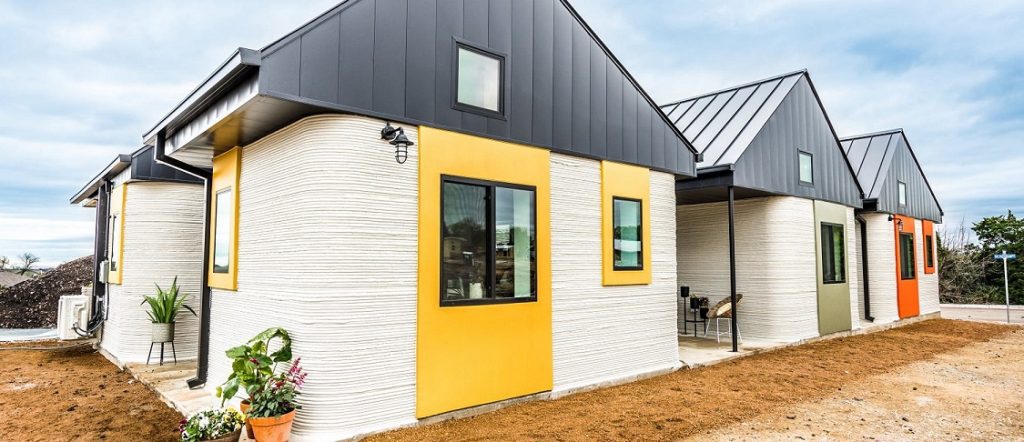Over the past 18 months, the new home market has faced a number of challenges, notably, the rise in building costs, shortage of building materials, supply chain issues, and access to qualified labor. These challenges are no doubt the direct effects of the Covid19 pandemic. With the demand for new homes is drastically outpacing the supply, innovative builders are turning to technology for solutions.
One innovative technology that is being applied to home building is 3D printing. This cutting-edge method is still in the early stages of use in residential construction, but more and more builders are testing it out alongside more traditional methods and equipment (which you can learn more about online). While acquiring the technology is still very pricey, the trade-offs are more cost-efficient building materials and reducing the need for skilled labor.
Consumer Interest in Purchasing 3D-Printed Homes
According to a recent survey conducted by Realtor.com and HarrisX, consumers are warming up to the idea of living in a 3D-printed home. The survey of just over 3,000 consumers found that 66% would consider living in one of these homes. Of the millennials in the survey, 75% said they would live in a 3D-printed house.
It appears that more and more consumers are becoming aware and comfortable with this up-and-coming method of homebuilding. Almost one-third of the survey respondents said they believe 3D printed homes will eventually replace the traditional methods of homebuilding.
Top Factors to Persuade Consumers to Purchase a 3D Printed Home
There are several building challenges that 3D printing solves. Factors such as cost, energy efficiency, build time, and custom options give this new method many advantages over traditional methods. Here is how the importance of these factors ranked with the respondents in the Realtor.com survey.
- Lower cost: 54%
- Increased energy efficiency: 51%
- More resistant to natural disasters: 42%
- Faster to build: 41%
- More customizable: 39%
- Produces less waste than traditional building methods: 32%
Skeptics of 3D Printed Home Construction
According to this Realtor.com survey, not everyone is sold on the idea of 3D-printed homes. One-third of the respondents made it clear that they did not see 3D home printing as a viable option now or even in the future. Here are the main factors they cited as reasons why they thought this new technology wasn’t for them.
- 36% want to wait and see how the technology pans out over time
- 22% say they prefer the aesthetics of a traditional home
- 22% believe it won’t last as long
- 18% say they don’t want their home to look exactly like their neighbors’ homes
Pros and Cons of 3D Printing Homes
As 3D printing continues to grow in popularity and availability in residential construction, consumers will need to mull over the pros and cons of this option. Let’s take a look at those pros and cons.
The Pros
Here are the top reasons why 3D printing is a good option for residential construction.
Lower Costs
3D printing technology allows builders to construct homes for almost 40 percent cheaper than traditional methods. While the cost of the printing technology is still quite hefty, there are extreme savings in labor, materials, and build time.
Sustainability
This one is becoming increasingly important. Especially to the younger generations of consumers. The building materials used for the structure are often made from a mixture of cement, sand, geopolymers, mud, wood, rice fibers, and various other recycled materials.
Structural Soundness and Earthquake Safety
The 3D printed house is built in a way that it doesn’t require stress points which are very prone to breaking. By distributing the force equally, it does not rely on supporting these stress points that much and as a result, it can withstand earthquakes of the aforementioned strength.


Speed of Construction
There is absolutely no comparison between 3D printing and traditional building methods when it comes to timelines. Homes can be 3D printed in a matter of a day or two (depending on size and layout). We all know that traditional construction can take months. Some projects can go a year or more before they are completed.
Way Less Waste
Traditional home construction produces a huge amount of wasted material over the span of the project. Every year, over one billion tons are produced in construction waste. The 3D printing process not only produces very little (if any) waste, but many of the materials used are recycled.
The Cons
The Loss of Jobs
On one hand, the lack of need for skilled labor is a benefit that keeps costs low in the 3D home printing process. On the other hand, there will be a significant loss of construction jobs if this method becomes mainstream.
Building Limitations
To this point, 3D printing is limited to the construction of interior and exterior walls. The rest of the home (window, doors, roof, plumbing systems, etc) still has to be constructed with traditional methods.
Lack of Regulations
Standard building regulations for the 3D printing process in residential construction have not caught up with the advancement of technology. In short, there aren’t many standards understood by local building code enforcers across the country. This can make things tricky when applying for permits and negotiating with builders.
Availability
As with any new technology, the availability of 3D printing is extremely sparse. It may be several years from now before it is widely available across the U.S.
Final Thoughts About 3D Printing for Residential Construction
The technology of 3D printing is extremely dynamic and promises to solve many different challenges in the world. There are still many obstacles that are preventing this technology from becoming an accessible method in residential construction. The pros of 3D printing homes definitely outweigh the cons. For this reason, it is likely that it will continue to grow in popularity and demand in the housing market.







